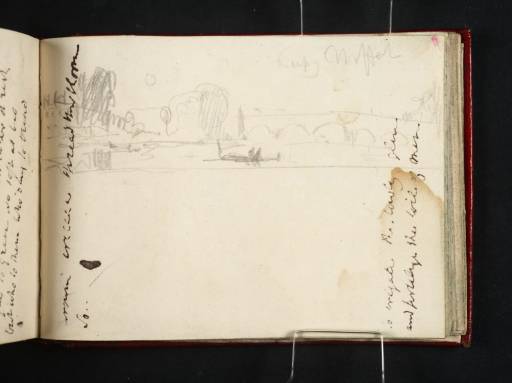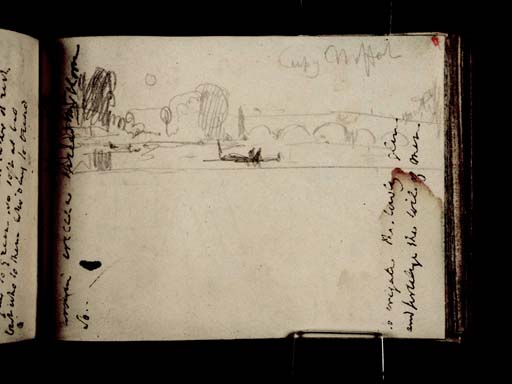Joseph Mallord William Turner River Scene, with Bridge and Boats, and Verses (Inscriptions by Turner) 1809
Image 1 of 2
Joseph Mallord William Turner,
River Scene, with Bridge and Boats, and Verses (Inscriptions by Turner)
1809
Joseph Mallord William Turner 1775–1851
Folio 16 Verso:
River Scene, with Bridge and Boats, and Verses (Inscriptions by Turner) 1809
D07879
Turner Bequest CXIII 16a
Turner Bequest CXIII 16a
Pencil on white wove paper, 83 x 114 mm
Inscribed by Turner in pencil ?‘Cupy’ or ‘Copy Moffatt’ top right and in ink with verses (see main catalogue entry) at left and right, running vertically
Inscribed by Turner in pencil ?‘Cupy’ or ‘Copy Moffatt’ top right and in ink with verses (see main catalogue entry) at left and right, running vertically
Accepted by the nation as part of the Turner Bequest 1856
References
1909
A.J. Finberg, A Complete Inventory of the Drawings of the Turner Bequest, London 1909, vol.I, p.308, CXIII 16a, as ‘River scene, with bridge and boats’.
1966
Jack Lindsay, J.M.W. Turner: His Life and Work: A Critical Biography, London 1966, p.150.
1974
Gerald Wilkinson, The Sketches of Turner, R.A. 1802–20: Genius of the Romantic, London 1974, p.104 reproduced.
1990
Andrew Wilton and Rosalind Mallord Turner, Painting and Poetry: Turner’s ‘Verse Book’ and his Work of 1804–12, exhibition catalogue, Tate Gallery, London 1990, p.168.
Drawn with the sketchbook inverted. Although it would be out of context in this book, this sketch might be somewhere on the Thames, with a ferry passing before a bridge. The water is dead calm and the sun is low in the sky to left. Turner’s inscription is tantalising but might read ‘Cupy’ or ‘Copy Moffatt’. If so, the only possible connection would be with his two pictures, The Seat of William Moffatt Esq., at Mortlake. Early (Summer’s) Morning (Frick Collection, New York)1 and Mortlake Terrace, the Seat of William Moffatt, Esq. Summer’s Evening (National Gallery of Art, Washington DC).2 William Moffatt did not move to The Limes on the south bank of the Thames at Mortlake until 1812 and Turner’s pictures were exhibited in 1826 and 1827 respectively, so if there were any direct connection this sketch would have to be significantly later than others in this book. More likely is that Turner was looking through it when working on the pictures or after they were painted, and was struck by the similarity of smooth water, river traffic and the disc of the sun low over the river to the effects especially in the Washington picture, which looks west towards Chiswick and Kew. Perhaps the boat is the Chiswick ferry. Turner’s note might be a reminder to himself to refer to the sketch while painting the picture or a recognition of their similarity. A further possibility is that his annotation refers to the Dutch painter Aelbert Cuyp, whose characteristic hazy, golden tones are recognisable but more vivid in both Mortlake pictures.
The verses are written running vertically on either side of the sketch; not mentioned by Finberg, they were first transcribed by Jack Lindsay, and then by Rosalind Mallord Turner, whose reading is followed here:
Brown spread their gloom
So
To irrigate the lowly glen
And privilege the will of men
So
To irrigate the lowly glen
And privilege the will of men
This short passage seems to belong to a longer poem about a shooting accident, for which see Introduction to the sketchbook and note to folio 13 verso (D07873).
David Blayney Brown
July 2009
How to cite
David Blayney Brown, ‘River Scene, with Bridge and Boats, and Verses (Inscriptions by Turner) 1809 by Joseph Mallord William Turner’, catalogue entry, July 2009, in David Blayney Brown (ed.), J.M.W. Turner: Sketchbooks, Drawings and Watercolours, Tate Research Publication, December 2012, https://www


